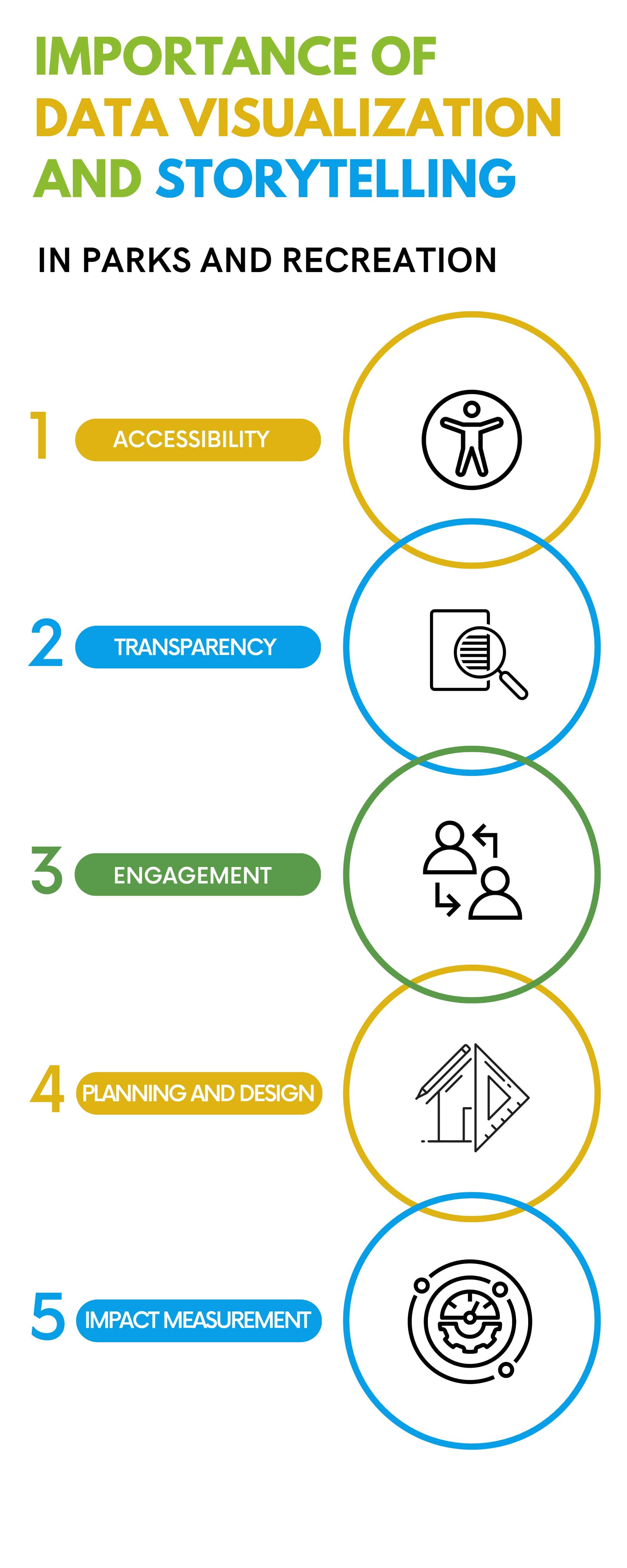
Visualizing the Value of Parks and Recreation: How Data Visualization and Storytelling Can Help
Author:Austin Stanfel
Parks and recreation departments are an essential part of any community. They provide a space for people to unite, get active, and enjoy nature. However, the data behind these departments can be overwhelming and challenging to understand. That is where data visualization and storytelling come in.
Data visualization is the graphical representation of information and data. It makes complex data more accessible and understandable to a broader audience. In the case of parks and recreation, data visualization can help people understand how their parks are being used, where resources are being allocated, and what improvements need to be made.
Storytelling is the art of conveying information through a narrative. In the context of parks and recreation, storytelling can help connect people to the importance of these spaces and how they impact their lives. By telling the story of a park or recreation center, people can understand the value of these spaces beyond just the data.
Data visualization and storytelling can create a powerful tool for parks and recreation departments to communicate with their communities and make data-driven decisions. One of the most significant benefits of data visualization is that it can help identify patterns and trends that might take time to become apparent. For example, by mapping out where people use the park, the department can identify the most popular and underutilized areas. This information can then be used to make informed decisions about where to allocate resources, such as adding more amenities to popular areas or investing in programs to increase usage in underutilized areas.
Data visualization can also be used to track progress over time. By creating visualizations that show how usage has changed over time, parks and recreation departments can see if their efforts to improve the space are having an impact. For example, if a park installs new playground equipment, the department can use data visualization to track if usage in that area increases after the installation.
One of the challenges that parks and recreation departments face is how to communicate the value of these spaces to their communities. This is where storytelling comes in. By telling the story of a park or recreation center, the department can connect with the community emotionally and demonstrate the value of these spaces beyond just the data.
For example, a department might create a video that tells the story of a family who uses the park regularly. The video could showcase their activities, such as picnicking, playing on the playground, or walking. By showing the park’s joy to this family, the department can connect with the community personally and make a case for why these spaces are essential.
Storytelling can also help to build community engagement. The department can foster a sense of ownership and pride in these spaces by involving the community in creating stories about the park or recreation center. For example, the department could host a community event where people can share their stories about how the park has impacted their lives.
Another way to use storytelling is to highlight the impact of the park on the broader community. For example, a department might tell the story of a community garden that provides fresh produce to people who might not have access to it otherwise. By showcasing how the park is making a difference in people’s lives, and the department can demonstrate the value of these spaces beyond just the recreational opportunities they provide.
Finally, data visualization and storytelling can create a more powerful tool for parks and recreation departments. By combining visual representations of data with compelling narratives, the department can communicate complex information in a way that is both accessible and emotionally engaging.
For example, the department might create a video that combines data visualizations with personal stories about how the park has impacted people’s lives. The video could show how people use the park, such as playing sports, attending events, or enjoying nature. By combining this information with personal stories, the department can create a powerful tool for communicating the park’s importance to the community.
In addition, data visualization and storytelling can be used to advocate for resources and funding for parks and recreation departments. By creating compelling visualizations and narratives demonstrating these spaces’ value, the department can make a case for why they need continued support from the community and government.
Here are a few additional points to consider when it comes to the importance of data visualization and storytelling in parks and recreation:
Accessibility: Data visualization can be beneficial for making information more accessible to people who may have difficulty processing large amounts of text-based information. Presenting data visually can be easier to understand and interpret, making it more inclusive for a wider audience.
Transparency: By sharing data through visualizations, parks and recreation departments can increase transparency and accountability. This can help build trust with the community and ensure that decisions are based on evidence rather than just intuition.
Engagement: Storytelling can be a powerful way to engage the community and foster a sense of ownership and pride in parks and recreation spaces. By sharing personal stories and creating emotional connections, the department can encourage people to invest more in their community’s parks and recreation spaces.
Planning and design: Data visualization can be a helpful tool in planning and designing parks and recreation spaces. The department can make informed decisions about allocating resources and designing spaces that meet the community’s needs by analyzing data on usage, demographics, and other factors.
Impact measurement: Data visualization can measure the impact of parks and recreation spaces on the community. By tracking metrics like usage, satisfaction, and economic impact, the department can demonstrate the value of these spaces to stakeholders and advocate for continued support and funding.
In conclusion, data visualization and storytelling play a crucial role in the success of parks and recreation departments. By harnessing the power of visual communication and emotional connection, these tools can help departments engage with their communities, build trust and transparency, and advocate for continued support and funding. From planning and design to impact measurement and beyond, data visualization and storytelling can be used at every stage to make informed decisions, create compelling narratives, and build stronger, more resilient communities.
However, it is worth noting that effective data visualization and storytelling require a certain level of skill and expertise. To truly harness the power of these tools, parks and recreation departments may need to invest in training or hiring professionals specializing in data visualization, design, and storytelling. Additionally, it is vital to ensure that these efforts are conducted with a focus on equity, inclusion, and accessibility so that all community members can benefit from and participate in the conversation.
Data visualization and storytelling in parks and recreation must be balanced. These tools are essential for creating deeper connections with the community, making data-driven decisions, and advocating for resources and support. By embracing the power of data visualization and storytelling, parks and recreation departments can build stronger, more vibrant communities that are resilient, sustainable, and equitable for everyone.


